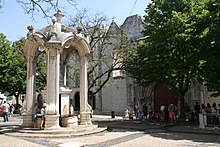Chiado
This article needs additional citations for verification. (July 2014) |
Chiado | |
|---|---|
Santa Maria Maior Misericórdia | |
| Foundation | 1567 |
The Chiado (Portuguese pronunciation:
Name

The
A bronze statue of the poet, by sculptor Costa Mota (tio), was placed in the Chiado Square in 1925.
History

The Chiado has been inhabited since at least Roman times, when several villae were present in the area.[3][4]
During the Middle Ages it was used for agricultural purposes and it was in its vicinity that North European
Between 1373 and 1375, during the reign of
In the 16th century, the area outside the city walls (present-day Bairro Alto) was also urbanised. The gate and walls were demolished in the early 18th century.
The
-
The ruins ofCarmo Convent, destroyed in the 1755 Lisbon earthquake
-
The Rococo interior ofBasilica of Our Lady of the Martyrs
-
Teatro Nacional de São Carlos,
Lisbon's national opera house -
The famous Café A Brasileira, former haunt of poets such as Fernando Pessoa
In the 18th and, especially, in the 19th century, a great number of important commercial establishments opened in the Chiado, turning it into a favourite shopping area. Some of them exist to this day, like the "Bertrand Bookshop" (opened 1747) and "Paris em Lisboa" (garment shop opened 1888). In 1792, Lisbon's

Museums were also created, like the Archaeological Museum in the former
1988 fire

In the early hours of August 25, 1988, a fire started at the Grandella department store in Rua do Carmo (Carmo Street) and quickly spread to Rua Garrett (Garrett Street) and others, affecting a total of 18 buildings (corresponding to an 8000 m2 land footprint) in the Chiado area, of which 11 were full losses with structure collapse, including the Armazéns do Chiado and Grandella department stores, that never reopened, along with several other historical shops also destroyed.[citation needed]
The fire was fought by 1,680 firefighters from throughout the country, and was put out by 16:00 local time. Several anecdotes indicate that the poorly equipped fire crews and access difficulties (especially at Rua do Carmo) combined with the extensive flammable contents (including gas bottles for sale on the stores) meant the firefighters struggled to cope with such a large scale urban fire. Two people were killed, and 73 were injured (60 of them firemen). Between 200 and 300 people lost their homes, and close to 2000 people lost their jobs. In terms of the extent of the city affected and number of destroyed buildings, the Chiado fire is often considered the worst disaster to strike the city since the 1755 Lisbon earthquake. Although it is known that the fire started with a slow combustion on the top floor of the Grandella building (which is unlikely in the event of intentional fire, that typically spreads quickly) the cause was never fully determined.
In 1989 the Portuguese architect
Landmarks
- A Brasileira
- Chiado Museum
- Carmo Convent
- Teatro Nacional de São Carlos
References
- ^ Article about the Chiado Fire, Jornal de Notícias.
- ^ "Chiado continua a ser 33ª zona comercial mais cara do mundo". Idealista. Retrieved 3 June 2019.
- ^ History of the Chiado[permanent dead link], Lisbon Municipality website. (in Portuguese)
- ^ History of Mártires parish in the Chiado Archived July 7, 2007, at the Wayback Machine. (in Portuguese)
External links
![]() Media related to Chiado at Wikimedia Commons
Media related to Chiado at Wikimedia Commons




